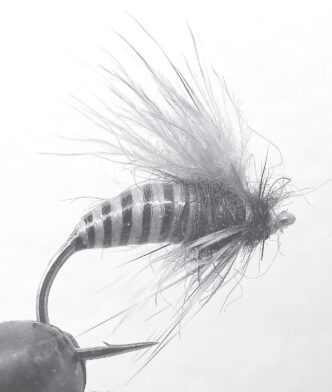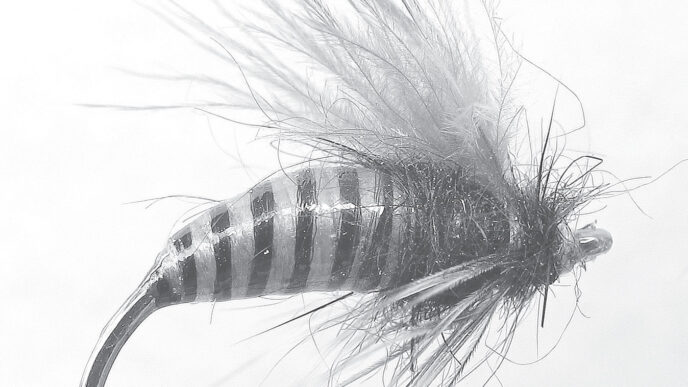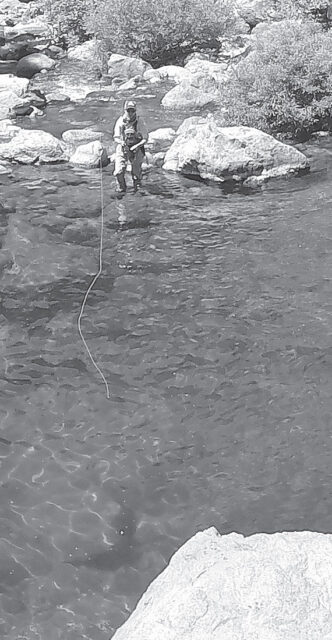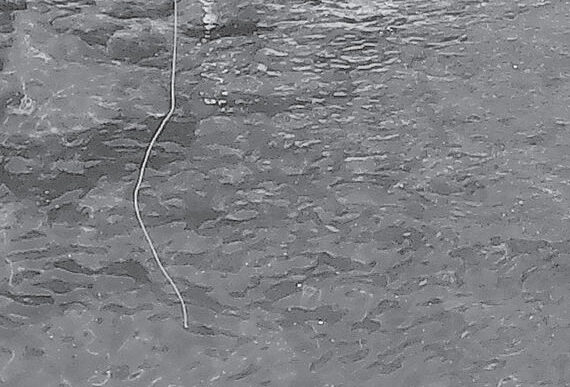Initially popularized for ocean use by Northeastern saltwater fly fishers in the early 1990s, double-handed rods have become popular for throwing flies into the Pacific surf. There’s no denying their rugged effectiveness. Despite what some might believe or claim, most fly fishers struggle to cast farther than 60 feet when using a single-handed rod in the surf. Give these same anglers a double-hander, and they can usually bang out 70-plus-foot casts, even if their loops are wide enough to swallow a point guard. That extra distance puts their flies in front of more fish.
Overkill?
I use a 7-weight double-hander whenever I feel the need to blast ginormous flies as far as humanly possible. Armed with a Skagit or Scandi head, these rods are great tools for connecting with big fish at long range. But the reality is that big fish and big bait aren’t the norm in the California surf. Most of the time, the suds are home to surfperch weighing one to three pounds. While they fight hard, there’s no denying that the typical 7-weight double-hander and matching 400-plus grains of fly line is overkill — the equivalent of fishing for trout with tarpon gear.
Many saltwater double-hander diehards use 6-weight or 7-weight Spey rods and heavy Skagit or tungsten-impregnated lines. I had been thinking about ways these folks could fish the same types of lines on lighter single-hand rods. I figured this might give them an incentive to use rods that actually bend, instead of just vibrating when a typical surfperch or schoolie striper is on the hook. I wasn’t completely sold on the idea, but was determined to explore it.
While attending The Fly Fishing Show in Pleasanton, I had a short chat with Brad Befus and Darin Elmore. I mentioned the single-handed-rod Skagit line idea. Darin had a better solution, suggesting I might take a look at troutweight Spey rods instead. I was aware that a few companies now make lighter Speys, but quite frankly had written them off as a bit of a fad. In retrospect, this was a mistake — not my first and unlikely my last. Trout-weight Spey rods (4-weights or lower) are designed to throw lines in the 200-to-250-grain range, which is the same line weight you’d typically use on a 7-weight or 8-weight single-handed rod. That’s almost perfect for the surf. It was clear I was going to have to get my hands on some of these rods and drag them down to the edge of the Pacific to harass some perch and schoolie stripers.
According to my research, there are currently five trout-weight Spey rods available from the major rod manufacturers: Redington’s Hydrogen Trout Spey, Scott’s T3H4, Winston’s Micro Spey, the Sage One Trout Spey, and Echo’s Boost Beach. Unfortunately, I did not find out about Scott’s rod in time for this article, so I don’t have hands-on experience with their rod. I contacted the manufacturers to request a demo rod, something I would recommend anyone do if considering buying a rod, but can’t try one out at a brick-and-mortar store.
Fresh to Salt
Lightweight double-handed rods are certainly an interesting way for folks to fish for trout and steelhead in big rivers and are especially useful when there is limited back-cast room. But as you might imagine, this isn’t the only way to get them wet. Even the lightest of them will handle 200 grains of line with an overhead cast, which means you don’t have to limit yourself to dinky little flies. These rods will handle shrimp, crab, and anchovy patterns with aplomb. They also throw a heck of a long line. That can be a really good recipe for the surf.
With the exception of the Echo, all of the rods were originally designed to Spey cast in fresh water. Echo’s Boost Beach rod was designed for overhead casting into salty waters.
Casting
The first few casts with a troutweight Spey rod are interesting. Most are so light you feel like you should be casting them single-handed. In fact, they can lay out a pretty good line with just one hand. In this regard, they are a bit like switch rods. But single-handed casting with a rod that is almost three yards long isn’t likely to be too good for your wrist and doesn’t tap into their full potential. Use both hands, and these rods become an easy way to cover a lot of water.
You may want to try some sort of Spey cast. That makes perfect sense on a river and can even work in the surf if the ocean is relatively calm. But once the water gets bumpy, you’ll find that the waves have an irritating habit of rolling in and grabbing the line just as you execute a sweep or try to set the anchor. Sometimes you can rescue the cast, but most of the time, the line gets buried under tons of salt water.
I spent several hours playing around with the rods to see what makes them sing. It turns out the answer is embarrassingly simple — if you know how to cast a spinning rod, you can cast these rods. How often do you hear that about fly casting? It boils down to three simple steps. Roll cast about 30 feet of line off the tip, make an overhead back cast, and deliver the fly on the subsequent forward cast. Yep, it really is that simple. But if you want to tap the full potential of these rods, there are four things that make a big difference.
Don’t be in a hurry. These rods don’t have a fast action, so you are going to have to get used to a slower pace. This is especially true if you are used to fast single-handed sticks. Folks who regularly use bamboo or glass will know the drill.
Both hands need to apply the same level of force. This is what British long-distance surfcasters refer to as the punch/pull move. The upper hand pushes the rod out, while the lower hand simultaneously pulls the butt toward the chest. This rotates the rod around a pivot located between your hands, which produces maximum leverage on the blank and as a result the highest tip speed. If you find it hard to punch and pull with equal force, consciously use the pulling hand on the lower grip to deliver most of the leverage. Knowing exactly when to start the forward cast can be a bit of a problem. If your casts keep coming up short or you get a lot of tailing loops, your timing is probably off. While some folks think watching your back cast is a mortal sin, I’d suggest you do just that. Just shrug off the withering looks of any pious bystanders. Watch your back cast a few times, and you’ll quickly get the timing dialed in.
Resist the urge to power through the cast. The rod will absorb the excess force, causing the tip to dive down, which is almost guaranteed to give you a tailing loop. At no point in the cast should you feel like you are using more than 50 percent of arm strength. You are working a very long lever, so even a modest amount of arm power is going to throw a lot of line.
Once you relax and allow the rod to do its job, casting becomes almost effortless. Even with a gentle cast, it’s not that unusual to see your fly land about 70 feet out. Once you really get used to the rod, you can churn out 80-plus-foot casts for hours on end. Getting that kind of performance from a single-handed rod can take a lot of practice. This setup is great for folks who have a dodgy double haul or who suffer from minor shoulder, elbow, or wrist problems.
One of the things you need to keep an eye on with these rods (just like any multipiece rod) is loose ferrules. The first ferrule, often located about 18 inches above the grip, seems to be the most likely to slip, but the middle ferrule can creep, too. As far as I can tell, there’s no consensus on the best way to deal with this particular problem. Some folks suggest you use electrical tape. Other swear by wax. I tried tape and I tried wax. Neither was a total cure. Now I simply check and, if necessary, reseat the ferrules every 15 minutes.
Which Stick Is Best?
I used to think you could adequately define a rod using physical parameters such as stiffness, taper, vibrational frequency, and swing weight. After countless hours conducting all kinds of tests, I realized these metrics get you only so far.
The simple truth is that most fly fishers base their rod preferences on feel, which depends on the rod and the human and is (at this time) still largely unquantifiable. As such, I can’t tell you which rod will be right for you. I can, however, give you an overview of the rods, which should help you decide which ones to consider trying out. At around 4 to 5 ounces and sporting progressive tapers, the Redington, Sage, and Winston rods all felt light in the hand and were more than capable of casting overhead. Not surprisingly, they executed Spey and roll casts with ease. All balanced nicely with an 8-ounce reel and are clearly quite suitable for both the surf and the river. The staff at Scott tell me their T3H4 rod weighs just under 5 ounces and has a full-flex action. This suggests to me that it will cast much like the others.

The Echo was a different animal. At 7 ounces, the rod is noticeably heavier and as a result balances better with a heavier reel. The manufacturer suggested using a reel of about 8 ounces. My personal preference was actually closer to 10 ounces. While it can Spey cast, this is clearly more of an overhand-style rod, which is exactly what the folks at Echo designed it for. This sturdy rod has no trouble dealing with the surf, but I suspect it’s a bit on the heavy side for most freshwater applications.
Lines
Initially, I thought that the combination of a long, Scandi-style shooting head and a slick shooting line would be the best setup for these rods. I was wrong (again). It turns out that the most practical setup in the surf is actually a typical singlehanded-rod-style weight-forward sinking line. They cast almost as far as the Scandi head setup, but without the hassle of worrying about overhang, clunky looped connections, or skinny-shooting-line tangles. I suspect pretty much any sinking weight-forward line in the 8-eight-to-10weight range (200 to 280 grains) will do the trick. I eventually settled on two lines. When the surf wasn’t too rough, I fished a “triple density” WF8S line, which cast smoothly and plenty far. The triple-density arrangement, which places a fastsink head and belly at the front, followed by a short slower-sink section and then an intermediate running line, handled the surf’s tumbling currents nicely and was well-behaved in the stripping basket. I don’t care how well a line casts, if it doesn’t like being in a basket, it’s bad news in the suds.
When the surf gets up, integrated heads, with their short, fast-sinking head section and easy-to-handle running lines are a great way to go. The short, dense head section can make them slightly clunky to cast, but is more than made up for by their utility. Several companies make these lines. One had a bright-green running line which was really helpful on foggy mornings, when the fishing is usually best. Little things like this make a noticeable difference when the surf really gets going. If you have an integrated head with a neutral-colored running line, you might want to drop it in some yellow Rit all-purpose dye to make it more visible.
Line Management
Don’t be too surprised if the line-to-backing knot gets tugged off the spool when you get the cast timing just right. This will give you the enviable problem of having to manage 100-plus feet of line. Not surprisingly, this pretty much eliminates casting without a stripping basket. Even if you have a basket, it may not be big enough to swallow an entire weight-forward line. You are going to want something with a capacity of at least three gallons. This is definitely a situation where more is better. A heavily ventilated 4-gallon or 5-gallon bucket or full-size dish pan should do the job. Mark Won, who probably puts in more time with double-handers than many Northwest steelhead guides, has built himself a humongous foam stripping basket that could easily accommodate a well-fed beagle. It looks ungainly, but there’s no denying that it swallows line like a black hole. If you don’t do DIY, the Hip Shooter by Mangrove Outfitters is just big enough.
Another problem with casting the entire line is dealing with backing. Regardless of what this might do for your ego, having backing off the reel is not a great way to fish the surf. Being softer and lighter, it will behave differently than the fly line. Even a slight onshore breeze will blow the stuff around. For folks casting off the right side of the body, this means backing will likely get blown over the basket by the typical northwest sea breeze. That can produce some nasty tangles when you cast.
The other problem is line twist, which is not uncommon when casting fast-sinking lines. Twisted fly line forms loose spirals, which you can remove by judiciously spinning the rod along its axis. Backing, however, responds to twist by becoming a macramé project. Been there, done that. If you absolutely have to cast over 100 feet, loop or splice another 10-to-20-foot piece of fly line onto the back of your main line.
Care and Feeding
All of these rods come with saltwater-safe components, so you don’t need to lose sleep worrying about rusty guides or pitted reel seats. A simple freshwater wash-down will ensure they keep fishing for a long time. I recommend paying extra attention to the reel seats. Sand has a habit of finding its way under the reel hoods and into the threads, which can complicate reel removal. Direct a gentle stream of fresh water onto the threads and remove the reel when you are done for the day.
Do You Really Need Another Rod?
According to the U.S. Census, over 68 percent of Californians live in the state’s coastal counties. That means there are a lot of fly fishers who live much closer to the Pacific than to any Sierra stream. If you have been thinking about fishing the surf or have tried it and realized your casting isn’t quite up to par, give serious consideration to trout-weight doubles. Easy to cast and light enough to be sporting with smaller fish, these rods could be what it takes to make the surf your home water.
I also suspect there’s a lot more you can do with these rods if you start to think slightly outside the box. For example, with the exception of the rather rugged Echo, these rods might also be a good way to fish many lowland ponds or high-Sierra lakes, where steep, rocky banks or trees hugging the water’s edge can make casting challenging. In addition, their length and lightweight suggest they’d also make pretty darn good lake dapping rods. Very few fly rods provide that kind of all-water multi-technique flexibility.
















